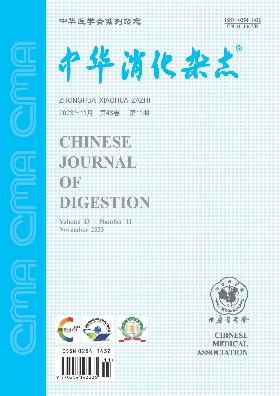Role and mechanism of tumor necrosis factor ligand-related molecule 1A in chronic experimental colitis associated intestinal fibrosis
引用次数: 0
Abstract
Objective To explore the role and mechanism of tumor necrosis factor ligand-related molecule 1A (TL1A) in chronic experimental colitis associated intestinal fibrosis. Methods The model of chronic experimental colitis-associated intestinal fibrosis was induced by dextran sodium sulfate (DSS). The mice with high TL1A (L-Tg) expression in lymphoid cells and wild-type mice with the same genetic background were divided into wild type control group, wild type DSS group, transgenic control group and transgenic DSS group. The changes of body mass, length of colon, disease activity index (DAI) and colonic pathological score were compared among different groups. The degree of colonic inflammation was evaluated by Hematoxylin-Eosin (H-E) staining. The degree of intestinal fibrosis was assessed by Masson staining and Sirius red staining. The expression of vimentin, α smooth muscle actin (α-SMA), type Ⅰ collagen, Ⅲ collagen and transforming growth factor-β1 (TGF-β1)/Smad3 in colon tissue was examined by immunohistochemistry. T test was performed for statistical analysis. Results The body mass of the transgenic DSS group decreased by (9.6±1.8)%, which was more than wild-type DSS group (6.2±1.3)%, the difference was statistically significant (t=3.751, P<0.01). The DAI score and colonic pathological score of transgenic DSS group were both higher than those of wild-type DSS group (7.33±0.58 vs. 6.00±1.00, and 14.00±1.05 vs. 11.75±0.50, respectively), and the differences were statistically significant (t=2.818 and 4.739, both P<0.05). The results of Masson staining and Sirius red staining showed aggravation of intestinal fibrosis. The results of immunohistochemical staining showed that the cumulative positive absorbance values of vimentin, α-SMA, TGF-β1 and Smad3 of wild-type DSS group were lower than those of transgenic DSS group (0.650±0.050 vs. 0.800±0.020, 0.390±0.040 vs. 0.600±0.040, 0.550±0.040 vs. 0.730±0.040, 0.590±0.020 vs. 0.830±0.040), and the differences were statistically significant (t=6.823, 9.093, 7.794 and 10.390, all P<0.01). Conclusion TL1A may promote the proliferation and activation of fibroblasts through TGF-β1/Smad3 pathway, leading to the genesis and development of experimental colitis associated intestinal fibrosis. Key words: Inflammatory bowel diseases; Intestinal fibrosis; Tumor necrosis factor ligand-related molecule 1A肿瘤坏死因子配体相关分子1A在慢性实验性结肠炎相关肠纤维化中的作用及机制
目的探讨肿瘤坏死因子配体相关分子1A (TL1A)在慢性实验性结肠炎相关肠纤维化中的作用及机制。方法采用右旋糖酐硫酸钠(DSS)诱导慢性实验性结肠炎相关性肠纤维化模型。将淋巴样细胞中TL1A (L-Tg)高表达小鼠和具有相同遗传背景的野生型小鼠分为野生型对照组、野生型DSS组、转基因对照组和转基因DSS组。比较各组大鼠体重、结肠长度、疾病活动指数(DAI)及结肠病理评分的变化。采用苏木精-伊红(H-E)染色评价结肠炎症程度。采用Masson染色和Sirius红染色评价肠纤维化程度。免疫组化法检测结肠组织中波形蛋白、α-平滑肌肌动蛋白(α- sma)、Ⅰ型胶原、Ⅲ型胶原及转化生长因子-β1 (TGF-β1)/Smad3的表达。采用T检验进行统计学分析。结果转基因DSS组体质量下降(9.6±1.8)%,高于野生型DSS组(6.2±1.3)%,差异有统计学意义(t=3.751, P<0.01)。转基因DSS组DAI评分和结肠病理评分均高于野生DSS组(分别为7.33±0.58∶6.00±1.00、14.00±1.05∶11.75±0.50),差异均有统计学意义(t=2.818、4.739,P均<0.05)。Masson染色和Sirius红染色显示肠纤维化加重。免疫组化染色结果显示,野生型DSS组vimentin、α-SMA、TGF-β1、Smad3的累积阳性吸光度值均低于转基因DSS组(0.650±0.050 vs. 0.800±0.020、0.390±0.040 vs. 0.600±0.040、0.550±0.040 vs. 0.730±0.040、0.590±0.020 vs. 0.830±0.040),差异均有统计学意义(t=6.823、9.093、7.794、10.390,P均<0.01)。结论TL1A可能通过TGF-β1/Smad3通路促进成纤维细胞增殖活化,参与实验性结肠炎相关性肠纤维化的发生发展。关键词:炎症性肠病;肠纤维化;肿瘤坏死因子配体相关分子1A
本文章由计算机程序翻译,如有差异,请以英文原文为准。
求助全文
约1分钟内获得全文
求助全文

 求助内容:
求助内容: 应助结果提醒方式:
应助结果提醒方式:


